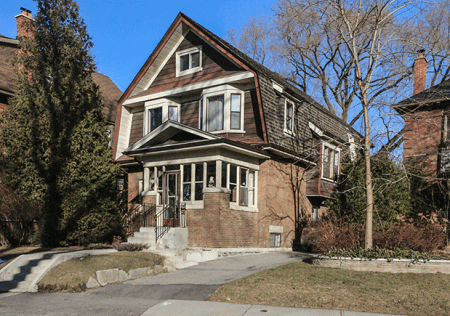Home prices in Toronto, Canada’s largest city, have risen dramatically in the years since 2008. The increases have been particularly striking within the ground-related housing segment and have market watchers speculating on when home prices will peak.
Recently published price data from the Toronto Real Estate Board pegs the average selling price in the Greater Toronto Area (GTA) for all housing types at $710,410, up 17.7 percent over the previous year. For detached homes in the GTA, the average price was $964,002, up 21.5 percent year-over-year.
With most market analysts in agreement that a slowdown will not materialize anytime soon, ULI Toronto convened a debate on housing affordability on September 15 at the Toronto Reference Library.
The debate, titled “Above Asking: Housing Affordability and the Greenbelt,” sought to examine the impact that provincial growth policies are having on affordability. The Ontario government is in the midst of updating four major land use plans enacted in the early to mid-2000s—the Growth Plan for the Greater Golden Horseshoe, the Greenbelt Plan, the Oak Ridges Moraine Conservation Plan, and the Niagara Escarpment Plan.
“These plans represent North America’s strongest public policy around the use of land and in achieving urban intensification and regional transit-oriented development,” said ULI Toronto Chair Derek Goring in his introduction, framing the debate. “But ten years after the original enactment of these plans, some are questioning whether they’ve had some unintended consequences.”
Some of the region’s land developers contend that the Greenbelt Plan, which created a 2,800-square-mile (7,300 sq km) area of protected green space, farmland, and forest that surrounds a densely populated region of southern Ontario known as the Golden Horseshoe, is partly responsible for the erosion of affordability. The Greenbelt itself has constrained the supply of buildable land and left buyers with fewer options for homeownership, they argue.
Participating in the debate were David Amborski, a professor at Ryerson University’s School of Urban and Regional Planning; Markus Moos of the University of Waterloo School of Planning; Pamela Blais of Metropole Consulting; and Russell Matthew of Hemson Consulting. Amborski and Moos opened the debate with presentations.
Neither side opposed the provincial growth policies outright, but Amborski and Matthew argued that mounting evidence suggests that these restrictive policies have contributed to the home price run-ups seen in the region. Moos and Blais were skeptical, countering that the role the policies have played in the erosion of affordability has been significantly overstated.
Amborski opened by affirming that he believes the Growth Plan and the Greenbelt are useful planning tools. But informed by his dual roles as an economist and an urban planner, Amborski said that it is important to look at the economic impacts of these policies. The impacts must be adequately examined before the province “doubles down” on these policies, which is how he characterized the recently proposed updates to the plans.
The central theme throughout Amborski’s presentation was the impact that government policies had on the supply of land. He described the Greenbelt as an “urban containment” policy that restricts land supply, a major input into house prices.
While Amborski acknowledged that, at this time, no direct evidence exists that these policies have affected house prices in Ontario, he cited several U.S. studies that have linked containment policies to rising house prices.
“This should be a warning for us,” he said, also pointing to a “tailing-off” of ground-related housing starts and an increase in lot prices as evidence of the policies’ impacts.
Stressing that he is not opposed to the policies, Amborski said we simply must recognize that the policies will have economic impacts and engage in studies to better understand those impacts. It is only then that steps can be taken to mitigate the negative effects the policies are having on land supply and, ultimately, affordability.
Moos began his own presentation by acknowledging a view he shares with Amborski—housing affordability is a major issue. But, he asked, “Is the Greenbelt to blame?”
Moos was quick to point out that he is unconvinced by the research that links land restrictions and higher housing costs cited by Amborski because it doesn’t successfully establish causality.
He argued that it’s necessary to turn to models of urban economics that look beyond the supply and demand framework and add geography as an element.
Accessibility determines the value of land and, as is expected behavior within a rapidly growing urban agglomeration, people want to be close to Toronto’s center, where the economic activity is focused.
“When you push up the price in the center, you get a proportional increase throughout the rest of the metropolitan region,” said Moos. Single-family home prices are increasing because the region is growing and demand exists for the higher-density center, not because there’s increased demand for single-family homes.
Moos also pointed to the Canadian government’s withdrawal from the country’s housing system as a factor affecting affordability. During the 1980s, between 15,000 and 20,000 units of affordable housing were built annually under Canada’s National Housing Act, but in the 2000s that number declined to 1,000 units annually. The result has been higher demand for market-rate housing. The effect of government policies that promote homeownership and the presence of foreign equity in the Toronto housing market also were covered.
“We may hold an opinion that we should all be able to afford ground-oriented single-family homes, but that doesn’t mean that it’s good public policy that looks at the costs and economic benefits of different types of land development patterns,” Moos concluded.
Matthew was next to speak and sided with Amborski, arguing that research on potential economic impacts of the current Growth Plan is insufficient. The impacts are important to understand, since Matthew believes the new Growth Plan proposals are a radical advancement of what was already “the most tightly regulated, reasonable plan ever attempted in Canada or the U.S. for an urban area.”
The region is already building the densest suburbs anywhere in Canada and the United States, according to Matthew, and the new proposals would see it become even denser. If the new plan is approved, the region may be worse off in ten years than if the old plan had not been changed or simply tweaked, he argued.
Blais advocated for a broader affordability discussion that moved beyond arguments over supply and demand and the Growth Plan and the Greenbelt. Both local and global factors are at play in the region’s housing market, she said, noting the relatively new development of globally mobile private and institutional capital landing in the region’s housing market.
Echoing Moos’s skepticism regarding the causal link between the region’s land use plans and the rising cost of housing, Blais also pointed to the sustained low interest rate environment present in Canada since the 2008 global financial crisis that roughly coincided with the introduction of the Growth Plan.
While the panelists remained divided on several issues as the event ended, it was clear that ongoing dialogue was essential to reaching a consensus on what can be done to improve affordability in Canada’s largest city and the role that land use plans will play in those solutions.
Event photography by Redflixx.







